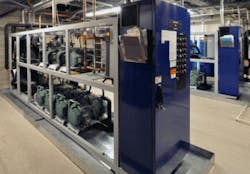Buildings account for 40% of the total energy consumed in the United States. Yet, according to a recent U.S. Department of Agriculture report, food-related energy use has grown to nearly 16% of the country’s total energy budget.
It’s not surprising then that the same forces impacting the HVACR industry are also affecting the food cold chain. Industrial refrigerated warehouses, food processors, transportation companies and food retailers are responding to a rapidly changing world in which fluctuating energy prices, new regulations, the phasedown of refrigerants with high global warming potential (GWP), technological innovation and globalization are shifting the nation’s food safety regime simultaneously and on multiple fronts. The cumulative impact of these various shifts is swift and transformative.
With SNAP rules dictating a transition to low-GWP refrigerants, efficiency, safety, environmental impact, chemical properties and economic factors all influence refrigerant choices in various applications.
With the pace of change only increasing across the HVACR industry, it’s imperative that refrigeration contractors and service professionals understand the impact of the following four challenges and how technology, policy and training will ultimately be the keys to industry change and adaptation.
#1: Energy
Similar to buildings and HVAC systems, energy and the food cold chain are inextricably linked. According to a recent report by two environmental engineering professors at Carnegie Mellon University, the average American household has a climate impact related to food of about 8.1 tons of carbon dioxide (CO2) per year, a significant#2: Globalization & Urbanization
In addition to rapid growth, global populations are becoming increasingly urbanized. According to the United Nations, 54% of the world’s population currently lives in cities, a figure projected to increase to 66% by 2050. Even as populations coalesce in cities, however, the global food chain is becoming more decentralized, as new sources and markets emerge. For example, the World Bank estimates that aquaculture — or fish farming — will provide nearly two-thirds of global fish consumption by 2030, compared with just over 42% today. Nearly all of that growth is expected to come from small-scale fish farms in developing countries.
On one hand, this shift from local to global food sources better facilitates the accessibility of diverse foods to the world’s population. But, it also creates new challenges in refrigeration and transportation to keep food fresh and safe — no matter how long or segmented the journey from farm to consumer.
#3: Regulations
Increasing reliance on a globalized food chain makes clear a basic reality: domestic governments alone cannot provide the level of inspection required by a global food chain to ensure safety. Thus, the Food Safety Modernization Act of 2011 (FSMA) marks the single biggest change in American food safety regulations since the inception of the FDA. The legislation effectively shifts key responsibilities for ensuring the integrity of food from the FDA to the private sector. In lieu of government inspections and enforcement, FSMA relies heavily on setting outcome standards and allowing the private sector to decide how to achieve those outcomes.
It is critical that installing and servicing contractors stay informed of the regulatory landscape and seek training for the newest technologies.
Recognizing the energy-intensity of the food cold chain and anticipating its growing climate impact, governments worldwide have been trying to collaboratively control emissions and atmospherically harmful substances — and are regulating independently in the near-term. In the U.S., the Obama Administration, under its Climate Action Plan, has authorized EPA to reduce greenhouse gas emissions from HFCs using the Significant New Alternatives Policy (SNAP). In September 2014, EPA proposed new SNAP rules that would prohibit the use of certain high-GWP hydrofluorocarbon (HFC) refrigerants, and allow the use of other climate-friendly alternatives in refrigeration systems. At the same time, regulations to control harmful emissions and improve energy efficiency are important to the future of energy-intensive applications such as those in the food/cold chain and built sectors.
Recently, EPA proposed a 30% reduction in carbon pollution from power plants as part of section 111(d) of the Clean Air Act. The effects of this rule could have wide-spanning impacts on energy efficiency and, particularly, large energy consumers.


